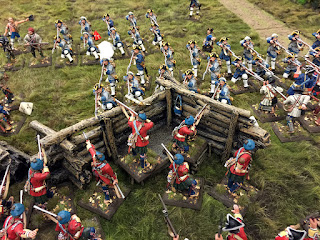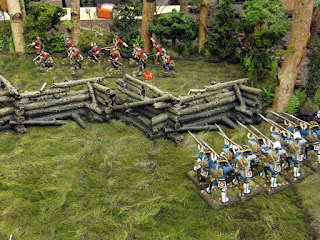We were surprised to have no "takers" for our third game of Black Powder on Saturday afternoon, so rather than tear down the table early, The Boy (aka Marshal) threw down the gauntlet. He said he'd seen the scenario played enough to have figured out how to win decisively as the French and would happily "show me." Game on!
Here are two previous posts for a refresher on the scenario, etc:
http://cluckamok.blogspot.com/2016/06/ready-to-roll.html
http://cluckamok.blogspot.com/2016/05/next-up-warlord-us-open-games-day.html
Deployments remained the same. The French immediately shifted the two Coureur units, which were largely ineffective in the previous two games, to the flanks, headed for the woods. The French Marines and Regulars advanced up the road toward the British works and the main body of arriving British and Colonial Regulars.
The British rushed their Indian allies on their left flank through the woods
to meet the advancing French-allied Indians and supporting Coureurs, then sent the Grenadiers into the woods on their right flank to counter the new French threat.
The firefight began in earnest between the lines of Regulars. Both sides received casualties but several "disorders" slowed down the French advance. Though the British Indians on the left flank slowed the French Skirmishers' progress, the addition of the Coureurs to this action forced the Indians back and eventually broke the "brigade."
Recognizing the threat now on the left flank, the British shifted the Colonial Militia unit to the left behind the works, both to support the weakening defenses there and to be in position to defend on the flank when needed. This move had the added benefit of clearing the field of fire for the only large unit in the game, the main body of the British 44th Regulars. The fire from the 44th soon broke the French Regulars facing it, and though the French had moved a unit of Marines into the woods on the British right, when their brigade broke their advance subsequently halted.
Now both sides had a broken brigade, on opposite flanks. The British right flank seemed more secure but the left flank was in trouble, so the British sent the Colonials into the woods on the left. Though the Colonials had performed well in both previous games, as a "Freshly Raised" unit their abilities were in question right up to their first combat action.
Luckily for the British, their firepower in the center caused another French brigade to break in the nick of time, so the Colonials weren't tested.
Win for the British - the only one in the 3 games played - in a very tense and fast-moving game.
So how did Black Powder handle the French and Indian War? Here are some observations. Please note these are personal observations and not a review, per se.
I did not expect to "like" Black Powder. I'd read the rules previously, along with their ancients cousin, Hail Caesar, and had dismissed them. I really did not like the idea of "announcing" the intent of orders prior to testing for them and the support rules seemed overly complicated. In play, announcing intent did not unduly "tip your hand" as intent was obvious in almost all cases whether the unit followed orders or not, and the support rules worked just fine.
I set the units up mostly as small units and with attributes as suggested in the Last Arguments of Kings supplement that covers the F&IW period. This meant most units had a "Stamina" of 2, meaning they took two hits before becoming "Shaken," so leaders have to manage these hits aggressively to keep the units in the game. The command and control rules are simple and really fun.
Formations are limited; in this period basically Line, Column, Attack Column and Skirmish. It's pretty obvious when you should be in any particular formation.
In most skirmish rules for the black powder period, reloading after shooting is a key component of the game system. Other games I play treat reloading as an action, and the action either limits or precludes your ability to take other actions in a turn. Black Powder "simulates" the action of reloading with two period-specific rules:
1) First Fire is an attribute that permits trained units to fire with one extra die on their first fire of the game, recognizing the care that can be given to the first load, perhaps in camp, prior to the engagement; and
2) a unit can't fire in a turn if it moved more than one move segment, which recognizes if a unit takes time to load their muskets, it is either going to take time away from movement, or slow down that movement if they are capable of loading "on the run."
I thought I would miss an actual "reloading" rule, but as I like to play "small battles" as opposed to "squad-level" skirmishes, this abstraction worked really well in play, and the decision points related to movement vs. fire are still present.
There are additional "chrome" rules regarding commander profiles that could add even more flavor to the game if used, and some work needs to be done on your own to introduce scenario and deployment rules, but the actual framework "for fightin'" is solid and complete. And fun!
This Warlord Open Games Day experience has finally driven home the fact that reading isn't enough - you have to play a game a few times to really "get" it. I had a great time playing Black Powder. I'm pretty sure I will play it some more.




























































